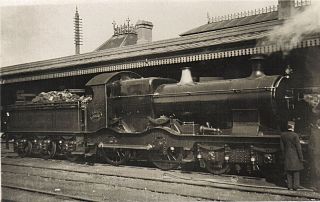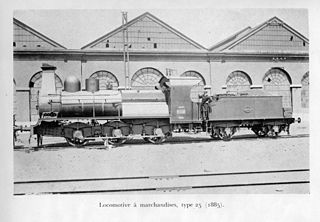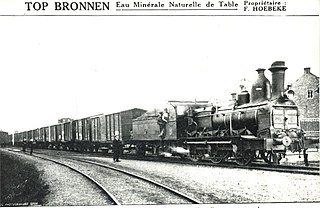| Belgian State Railways Type 32 | |||||||||||||||||||||||||||||||
|---|---|---|---|---|---|---|---|---|---|---|---|---|---|---|---|---|---|---|---|---|---|---|---|---|---|---|---|---|---|---|---|
 Type 32S at the Ottignies station, circa 1910. | |||||||||||||||||||||||||||||||
| |||||||||||||||||||||||||||||||
| |||||||||||||||||||||||||||||||
| |||||||||||||||||||||||||||||||
| |||||||||||||||||||||||||||||||
The Belgian State Railways Type 32 was a class of 0-6-0 steam locomotives for mixed service, introduced in 1902. [1]
| Belgian State Railways Type 32 | |||||||||||||||||||||||||||||||
|---|---|---|---|---|---|---|---|---|---|---|---|---|---|---|---|---|---|---|---|---|---|---|---|---|---|---|---|---|---|---|---|
 Type 32S at the Ottignies station, circa 1910. | |||||||||||||||||||||||||||||||
| |||||||||||||||||||||||||||||||
| |||||||||||||||||||||||||||||||
| |||||||||||||||||||||||||||||||
| |||||||||||||||||||||||||||||||
The Belgian State Railways Type 32 was a class of 0-6-0 steam locomotives for mixed service, introduced in 1902. [1]
In total, 502 Type 32 locomotives were built by various manufacturers from 1902 to 1910. [1]
The machines had an inside frame with the cylinders and the Stephenson valve gear also located inside. [2]
From 1905–1913 additionally 307 machines of the Type 32S, a closely related superheated variant, were built. The Type 32S had slightly different dimensions.
| Date ordered | État Belge numbers | Type | Quantity Type 32 | Quantity Type 32S | Date in service | Manufacturer / Factory numbers |
|---|---|---|---|---|---|---|
| 1901 | EB 2893–2911 | Type 32 | 19 | 1902 | Tubize [4] 1287–1305 | |
| 1901 | EB 2912–2925 | Type 32 | 14 | 1902 | Couillet [5] 1338–1351 | |
| 1901 | EB 2926–2941 | Type 32 | 16 | 1902 | Haine-Saint-Pierre [6] 713–728 | |
| 1901 | EB 2942–2953 | Type 32 | 12 | 1902 | Franco-Belge [7] 1394–1405 | |
| 1901 | EB 2954–2966 | Type 32 | 13 | 1902 | La Meuse 1723, 1726–1737 | |
| 1901 | EB 2967–2977 | Type 32 | 11 | 1902 | Carels [8] 390–400 | |
| 1901 | EB 2978–2986 | Type 32 | 9 | 1902 | Énergie [9] 69–77 | |
| 1901 | EB 2987–2992 | Type 32 | 6 | 1902 | Thiriau 19–24 | |
| 1902 | EB 2993–3004 | Type 32 | 12 | 1903 | Cockerill [10] 2406–2417 | |
| 1902 | EB 3005–3012 | Type 32 | 8 | 1903 | Tubize 1330–1337 | |
| 1902 | EB 3013–3032 | Type 32 | 20 | 1903 | Franco-Belge 1406–1425 | |
| 1902 | EB 3033–3050 | Type 32 | 18 | 1903 | Couillet 1354–1371 | |
| 1902 | EB 3051–3067 | Type 32 | 17 | 1903 | La Meuse 1768–1784 | |
| 1902 | EB 3068–3075 | Type 32 | 8 | 1903 | Thiriau 31–38 | |
| 1902 | EB 3076–3081 | Type 32 | 6 | 1903 | Énergie 81–86 | |
| 1903 | EB 3082–3084 | Type 32 | 3 | 1904 | Biesme 16–18 | |
| 1903 | EB 3085–3094 | Type 32 | 10 | 1904 | Franco-Belge 1474–1483 | |
| 1903 | EB 3095–3103 | Type 32 | 9 | 1904 | Saint-Léonard [11] 1383–1391 | |
| 1903 | EB 3104–3112 | Type 32 | 9 | 1904 | Tubize 1392–1400 | |
| 1903 | EB 3113–3116 | Type 32 | 4 | 1904 | Thiriau 45–48 | |
| 1903 | EB 3117–3126 | Type 32 | 10 | 1904 | Couillet 1394–1403 | |
| 1903 | EB 3127–3132 | Type 32 | 6 | 1904 | Carels 422–427 | |
| 1903 | EB 3133–3141 | Type 32 | 9 | 1904 | Cockerill 2470–2478 | |
| 1904 | EB 3142 | Type 32 | 1 | 1905 | Biesme 19 | |
| 1904 | EB 3143 | Type 32S | 1 | 1905 | Saint-Léonard 1398 | |
| 1904 | EB 3144–3147 | Type 32 | 4 | 1905 | Cockerill 2502–2505 | |
| 1904 | EB 3148 | Type 32 | 1 | 1905 | Biesme 22 | |
| 1906 | EB 3149–3153 | Type 32S | 5 | 1905–1906 | Franco-Belge 1510–1514 | |
| 1906 | EB 3154–3159 | Type 32 | 6 | 1906 | Haine-Saint-Pierre 873–878 | |
| 1906 | EB 3160–3176 | Type 32 | 17 | 1906–1907 | Cockerill 2543–2550, 2566–2574 | |
| 1906 | EB 3177–3181 | Type 32 | 5 | 1906 | Saint-Léonard 1455–1459 | |
| 1906 | EB 3182–3189 | Type 32 | 8 | 1906–1907 | Énergie 138–145 | |
| 1906 | EB 3401–3416 | Type 32S | 16 | 1906–1907 | Tubize 1477–1492 | |
| 1906 | EB 3417–3424 | Type 32S | 8 | 1906–1907 | Couillet 1443–1450 | |
| 1906 | EB 3425–3435 | Type 32S | 11 | 1906–1907 | Franco-Belge 1611–1621 | |
| 1906 | EB 3436 | Type 32S | 1 | 1907 | Biesme 31 | |
| 1906 | EB 3437–3444 | Type 32S | 8 | 1906–1907 | Haine-Saint-Pierre 879–886 | |
| 1906 | EB 3445–3449 | Type 32S | 5 | 1906 | Saint-Léonard 1450–1454 | |
| 1906 | EB 3450–3458 | Type 32 | 9 | 1906–1907 | Couillet 1432–1436, 1438–1441 | |
| 1906 | EB 3459–3464 | Type 32 | 6 | 1906 | Franco-Belge 1605–1610 | |
| 1906 | EB 3465–3469 | Type 32 | 5 | 1907 | Carels 451–455 | |
| 1906 | EB 3470–3473 | Type 32 | 4 | 1906–1907 | Biesme 27–30 | |
| 1906 | EB 3474–3476 | Type 32 | 3 | 1906–1907 | Gilain 10–12 | |
| 1906 | EB 3477–3478 | Type 32 | 2 | 1907 | Detombay 172–173 | |
| 1906 | EB 3479–3484 | Type 32 | 6 | 1907 | Gilly 280–285 | |
| 1906 | EB 3485–3490 | Type 32S | 6 | 1907 | Gilain 17–22 | |
| 1906 | EB 3491–3496 | Type 32S | 6 | 1907–1908 | Biesme 36–41 | |
| 1906 | EB 3497–3506 | Type 32S | 10 | 1907 | Haine-Saint-Pierre 913–922 | |
| 1906 | EB 3507–3514 | Type 32S | 8 | 1907 | Carels 462–469 | |
| 1906 | EB 3515–3521 | Type 32S | 7 | 1907 | Énergie 150–156 | |
| 1906 | EB 3522–3533 | Type 32S | 12 | 1908 | Franco-Belge 1629–1640 | |
| 1906 | EB 3534–3544 | Type 32S | 11 | 1907 | Tubize 1509–1519 | |
| 1906 | EB 3545–3550 | Type 32 | 6 | 1908 | Detombay 174–179 | |
| 1906 | EB 3551–3556 | Type 32 | 6 | 1907 | Gilly 299–304 | |
| 1906 | EB 3557–3559 | Type 32 | 3 | 1907 | Énergie 146–148 | |
| 1906 | EB 3560–3565 | Type 32 | 6 | 1907 | Haine-Saint-Pierre 923–928 | |
| 1906 | EB 3566 | Type 32 | 1 | 1907 | Énergie 149 | |
| 1906 | EB 3567–3576 | Type 32 | 10 | 1907 | Cockerill 2612–2621 | |
| 1906 | EB 3577–3588 | Type 32 | 12 | 1907–1908 | Couillet 1462–1473 | |
| 1906 | EB 3589 | Type 32 | 1 | 1907 | Gilly 305 | |
| 1906 | EB 3590–3598 | Type 32 | 9 | 1907 | Saint-Léonard 1489–1497 | |
| 1906 | EB 3599–3604 | Type 32 | 6 | 1907 | Carels 456–461 | |
| 1907 | EB 3605–3617 | Type 32 | 13 | 1908 | Saint-Léonard 1533–1545 | |
| 1907 | EB 3618–3621 | Type 32 | 4 | 1908 | La Meuse 2127–2130 | |
| 1907 | EB 3622–3634 | Type 32 | 13 | 1908 | Cockerill 2660–2672 | |
| 1907 | EB 3635–3647 | Type 32 | 13 | 1908 | Franco-Belge 1707–1719 | |
| 1907 | EB 3648–3668 | Type 32 | 21 | 1908 | Couillet 1479–1499 | |
| 1907 | EB 3669–3674 | Type 32 | 6 | 1908 | Gilly 330–335 | |
| 1907 | EB 3730–3741 | Type 32S | 12 | 1908 | Haine-Saint-Pierre 959–970 | |
| 1907 | EB 3742–3754 | Type 32S | 13 | 1908 | Tubize 1549–1561 | |
| 1907 | EB 3755–3769 | Type 32S | 15 | 1908 | Carels 480–484, 476–479, 470–475 | |
| 1907 | EB 3770–3781 | Type 32S | 12 | 1908 | Énergie 168–179 | |
| 1907 | EB 3782–3792 | Type 32S | 11 | 1908 | Thiriau 110–120 | |
| 1907 | EB 3793–3799 | Type 32S | 7 | 1908 | Biesme 42–48 | |
| 1907 | EB 3800–3805 | Type 32S | 6 | 1908 | Gilain 23–28 | |
| 1908 | EB 3806–3815 | Type 32 | 10 | 1909 | Saint-Léonard 1593–1602 | |
| 1908 | EB 3816–3828 | Type 32 | 13 | 1909 | Tubize 1595–1607 | |
| 1908 | EB 3829–3840 | Type 32 | 12 | 1909 | Franco-Belge 1793–1804 | |
| 1908 | EB 3841–3846 | Type 32 | 6 | 1909 | Cockerill 2707–2712 | |
| 1908 | EB 3847–3851 | Type 32 | 5 | 1910 | Detombay 185–189 | |
| 1908 | EB 4201–4211 | Type 32S | 11 | 1909–1910 | Thiriau 137–142, 149–153 | |
| 1908 | EB 4212–4227 | Type 32S | 16 | 1909–1910 | Carels 485–489, 496–506 | |
| 1908 | EB 4228–4240 | Type 32S | 13 | 1909–1910 | Énergie 216–228 | |
| 1908 | EB 4241–4246 | Type 32S | 6 | 1909–1910 | Biesme 53–58 | |
| 1908 | EB 4247–4253 | Type 32S | 7 | 1909 | Haine-Saint-Pierre 1001–1006, 1030 | |
| 1908 | EB 4254–4272 | Type 32S | 19 | 1909–1910 | La Meuse 2194–2212 | |
| 1908 | EB 4273–4282 | Type 32S | 10 | 1910 | Franco-Belge 1805–1814 | |
| 1908 | EB 4283–4285 | Type 32S | 3 | 1910 | Detombay 190–192 | |
| 1908 | EB 4286–4297 | Type 32S | 12 | 1909–1910 | Gilain 36–47 | |
| 1908 | EB 4298–4310 | Type 32S | 13 | 1909–1910 | Gilly 351–363 | |
| 1909 | EB 4311 | Type 32S | 1 | 1910 | Detombay 193 | |
| 1912 | EB 4312–4316 | Type 32S | 5 | 1914 | Saint-Léonard 1807–1811 |

The Bulldog and Bird classes were double-framed inside cylinder 4-4-0 steam locomotives used for passenger services on the Great Western Railway. The Bird Class were a development of the Bulldogs with strengthened outside frames, of which a total of fifteen were built. A total of 121 Bulldogs were built new, with a further twenty rebuilt from Duke Class locomotives. Thirty Bulldogs were later rebuilt as Earl Class locomotives and renumbered 3265, 3200-3228.

The goods train locomotives of Class C VI were German steam engines built between 1899 and 1905 for the Royal Bavarian State Railways. It had great similarity to the Prussian G 5.4, but had a higher boiler overpressure and better riding qualities. In all the Bavarian state railways procured 83 engines of this type over that period. More machines with slight modifications were acquired between 1907 and 1909. These 37 engines were given the designation G 3/4 N. The Deutsche Reichsbahn inherited 64 Class C VI and 32 Class G 3/4 N engines. These were given operating numbers 54 1301–1364 and 54 1401–1432. The Class C VII locomotives remained in service until 1931, their Class G 3/4 N sister locomotives until 1935.
The Prussian Class G 5.1 steam engines were the first 2-6-0 goods locomotives in Europe. They were developed for the Prussian state railways from the Class G 4 and a total of no less than 264 units of this class were placed in service in Prussia between 1892 and 1902. The twin-cylinder G 5.1 had been designed to raise the speed of goods trains on main lines. In addition, more powerful engines were needed for the increasingly heavy train loads. The locomotives, which were equipped with a compressed air brake, were used in charge of fast goods trains (Eilgüterzugdienst) and also passenger trains due to their impressive top speed of 65 km/h. The G 5.1 was fitted with inside Allan valve gear and the carrying wheels were of the Adams axle design. The engines were coupled with tenders of Class pr 3 T 12. In Prussian service they were renumbered in 1905 into the 4001–4150 range.

The Caledonian Railway 721 Class was a class of 4-4-0 steam locomotives designed by John F. McIntosh for the Caledonian Railway (CR) and introduced in 1896. All survived to be absorbed by the London, Midland and Scottish Railway (LMS) in 1923 and a few survived into British Railways (BR) ownership in 1948.

The NMBS/SNCB Type 12 was a class of 4-4-2 steam locomotives built in 1938–1939 for the fast lightweight Ostend boat trains operated by the National Railway Company of Belgium.

The Belgian State Railways Type 10, later known as the NMBS/SNCB Type 10, was a class of 4-6-2 steam locomotives built between 1910 and 1914.

The NMBS/SNCB Type 64 was a class of 4-6-0 steam locomotives built as Prussian P 8s for German railways, delivered as war reparations to Belgium at the end of World War I. 168 locomotives of this type were delivered to Belgium, working mostly on light passenger trains operated by the National Railway Company of Belgium (NMBS/SNCB). The final locomotives of this type were withdrawn in 1967, marking the end of steam service in the country.

The Belgian State Railways Type 1 was a class of 2-4-0 steam locomotives for passenger service, introduced in 1864.

The Belgian State Railways Type 12 was a class of 2-4-2 steam locomotives for express passenger service, introduced in 1888. They were the successors of the Belgian State Railways Type 1 locomotives.

The Belgian State Railways Type 25 was a class of 0-6-0 steam locomotives for freight service, introduced in 1884.

The Belgian State Railways Type 28 was a class of 0-6-0 steam locomotives for freight service, introduced in 1864.
The Belgian State Railways Type 29 was a class of 0-6-0 steam locomotives for freight service, introduced in 1875.
The Belgian State Railways Type 2 was a class of 0-6-0 steam locomotives for passenger service, introduced in 1875. Alfred Belpaire derived the locomotive design from the Type 28 by replacing the 1,450 mm (57.09 in) wheels of the Type 28 with larger 1,700 mm (66.93 in) diameter ones.

The Belgian State Railways Type 51 was a class of 0-6-0T steam locomotives for shunting and local train service, introduced in 1866.
The Belgian State Railways Type 5 was a class of 2-4-0T steam locomotives for local passenger service, introduced in 1880.
The Belgian State Railways Type 20 was a class of 0-8-0T steam locomotives, introduced in 1870.
The Belgian State Railways Type 11 was a class of 0-6-0T steam locomotives for local passenger traffic, introduced in 1888. It gradually replaced the Type 5 in this role.
The Belgian State Railways Type 6 was a class of 2-6-0 steam locomotives for express passenger service, introduced in 1885.
The Belgian State Railways Type 4 was a class of 2-6-2T steam locomotives for passenger traffic, introduced in 1878.

The Belgian State Railways Type 30 was a class of 0-6-0 steam locomotives for mixed service, introduced in 1900.